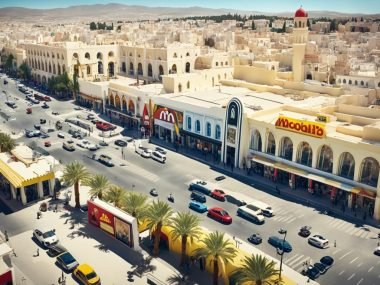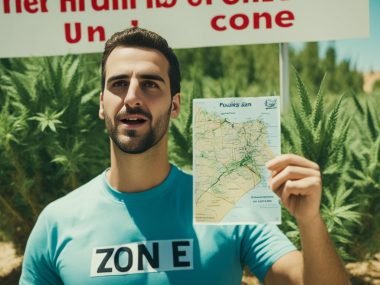Did you know North Africa has seven countries, including Tunisia, Morocco, and Libya? Together, they make up nearly a third of Africa’s total GDP. They are close by, in the north part of Africa. They share not just a spot on the map, but also interesting things in common.
All of them are in the Arab World with mostly Islamic people. The Arab uprising in 2011 affected them a lot. This shows how their history and location link them together.
Key Takeaways
- North Africa, including Tunisia, Morocco, and Libya, contributes to one-third of Africa’s GDP.
- They share a strategic geographic position in the northernmost part of the continent.
- These nations are part of the Arab World and have predominately Islamic populations.
- The Arab uprising of 2011 significantly influenced all three countries.
- Libya is particularly renowned for its significant oil production, contributing to its economic profile.
Introduction to the Geographical Placement of North African Countries
The lands of North Africa are full of different places. They have coasts and big deserts. The UN says Africa has five big areas, and North Africa has countries like Tunisia, Morocco, and Libya. These countries are different but also share some of the same types of land.
Tunisia, Morocco, and Libya have both things that are the same and things that are different. They have beaches in the north. Below, the land turns into the big, dry Sahara Desert. This mix of beach and desert is very important for the people living there.
There are many types of weather because the land is different in different parts. Near the sea, the weather is nice, and many people live there. Yet, the desert is very dry and not many people live there. But it’s still important because of the things you can find there. These places help the countries work together and do well.
Looking at how Tunisia, Morocco, and Libya are alike shows how they are connected. They have busy coasts and quiet deserts. The lands in these North African countries are special and different.
The Maghreb: A Specific Subregion in North Africa
The Maghreb includes Tunisia, Morocco, and Libya. It stands out in North Africa. These countries share many geographical features.
Shared Characteristics of the Maghreb
Tunisia, Morocco, and Libya are known for their Islamic faith. Arabic is also widely spoken here. Their culture, food, and architecture show a mix of old and new. This mix is due to the Mediterranean.
| Country | Language | Religion | Influences |
|---|---|---|---|
| Tunisia | Arabic | Islam | Mediterranean |
| Morocco | Arabic | Islam | Mediterranean |
| Libya | Arabic | Islam | Mediterranean |
Historical Context and Cultural Unity
Looking back at Tunisia, Morocco, and Libya, we see how history has shaped them. They were changed by Arab rule and European control. This has created their unique culture and politics today.
They all try to work together economically and politically. The Arab Maghreb Union is one example. Even with political problems, they still want to be unified and improve.
Proximity to the Mediterranean Sea
Tunisia, Morocco, and Libya have long coastlines along the Mediterranean Sea. These coastlines help in trade and cultural exchange. They use their location near Europe to boost their economy and diplomacy.

The Mediterranean Sea has always been important for trade. The positions of Tunisia, Morocco, and Libya helped them grow economically. Their coastlines were also key for military plans in history.
Being close to the Mediterranean Sea also brings these countries closer culturally. It makes exchanging ideas and traditions easy. This has also affected the way people move and the mix of cultures in these countries.
The Influence of the Sahara Desert
The Sahara Desert hugely impacts Tunisia, Morocco, and Libya. It covers a big part of these countries. It shapes their lands and their weather.
The Sahara’s Geographic Domination
The Sahara Desert is very big in Tunisia, Morocco, and Libya. It makes the middle of these countries dry and hot. This desert affects where people live and work.
Impacts on Climate and Habitation
The Sahara makes the climate in these countries very hot in summer and cold in winter. It hardly rains. This makes living in these areas hard, pushing people to live by the coast.
| Feature | Tunisia | Morocco | Libya |
|---|---|---|---|
| Geographical Traits | Coastline | Atlas Mountains | Vast Desert Plains |
| Population Distribution | Coastal cities | Urban settlements, Coastal towns | Coastal belt cities |
| Climate | Mediterranean, Desert | Mediterranean, Desert | Desert, Coastal influences |
Tunisia, Morocco, and Libya have two main areas: coast and desert. These places offer different lives and jobs to the people there.
Colonial Histories and Boundaries
The past actions of Tunisia, Morocco, and Libya with colonies impact their boundaries and society today. These effects can be seen in their systems for rules, education, and how they are run.
French and Italian Colonial Legacies
Tunisia and Morocco were once part of the French empire. They took a lot from the French way of running things and learning. Libya, however, was shaped by Italy. Their methods were put in place by the Italians.
These colonial pasts have left unique signs in Tunisia, Morocco, and Libya. They also show how their locations are similar after colonial times. Languages show clear marks of these times. French is still big in Tunisia and Morocco. Italian shows up sometimes in Libya.
| Country | Colonial Power | Influences |
|---|---|---|
| Tunisia | France | Language, Education, Legal System |
| Morocco | France | Language, Education, Legal System |
| Libya | Italy | Infrastructure, Administrative Structures |
Economic Similarities Among Tunisia, Morocco, and Libya
Tunisia, Morocco, and Libya share economic traits, focusing on agriculture, tourism, and natural resources. These sectors are vital due to their North African location.
Agriculture is key in all three countries. Tunisia and Morocco’s climates help grow olives, citrus, and cereals.
Morocco and Tunisia boost farm output in dry areas. Libya, mostly desert, improves farming with projects like the Great Man-Made River.
Tourism flourishes thanks to beautiful coasts, cultural sites, and historical riches. Tunisia has lovely resorts, Morocco has lively markets, and Libya has ancient sites. They all welcome lots of tourists.
“The coastal allure of Tunisia, Morocco, and Libya continues to draw international tourists, bolstering their economies significantly.”
Libya stands out with huge oil wealth. This industry dominates its GDP. Tunisia and Morocco, less rich in oil, still profit from mining and exploring energy.
In short, these countries’ economic links come from their shared region. Coastal riches, desert farming, and history unite their economies.
Climate Patterns Across North Africa
North Africa’s climate varies greatly from the coast to the inland areas. Countries like Tunisia, Morocco, and Libya show these differences. This is due to their different geographic features.
Variation in Coastal and Inland Climates
Near the Mediterranean Sea, the weather is usually mild and wet in winter. In summer, it gets hot and dry. This weather is good for farming and supports lots of people.
But, further inland, it’s much drier, like in the Sahara Desert. Here, Tunisia, Morocco, and Libya have similar geographies. The land sees big temperature changes and little rain. This affects how people live.
Impact on Agriculture and Lifestyles
The weather affects farming and how people live in North Africa. Near the coast, people can grow olives, fruits, and grains. But it’s harder to farm in dry inland areas. So, people there often move around with their animals. This shows how geography and farming are linked in these countries. Thus, most people live near the coast, sharing similar landscapes.
The Role of Islam as a Unifying Religion
Islam connects Tunisia, Morocco, and Libya deeply. These countries are close to each other. They all follow Sunni Islam strongly. This faith brings their people together, making them feel united.
“Islam serves as both a spiritual guide and a societal cornerstone in Tunisia, Morocco, and Libya. Historically, the spread of Islam brought not only religious changes but also cultural and legal transformations that continue to influence these nations today.”
Tunisia, Morocco, and Libya share much in being part of the Islamic world. They practice Sunni Islam and share strong bonds. This shared faith makes their relationships stronger and their politics more connected.
| Aspect | Tunisia | Morocco | Libya |
|---|---|---|---|
| Predominant Sect | Sunni Islam | Sunni Islam | Sunni Islam |
| Legal Influence | Sharia-based Family Law | Maliki School of Islamic Jurisprudence | Sharia-based Legal Principles |
| Religious Holidays | Eid al-Fitr, Eid al-Adha | Eid al-Fitr, Eid al-Adha | Eid al-Fitr, Eid al-Adha |
Islam’s role in uniting Tunisia, Morocco, and Libya is really important. They share cultures because they are in the same location. This helps them work together closely.
Geological Features of Tunisia, Morocco, and Libya
The North Africa countries show a rich mix of land features. These features are key to understanding Tunisia, Morocco, and Libya. Each country has its own unique geological traits.

The Atlas Mountains are a major highlight in Tunisia and Morocco. These mountains influence the weather and offer mineral riches. The Sahara Desert spreads across Libya, reaching into Tunisia and Morocco. It highlights the dry nature of these lands.
| Country | Key Geological Features | Significance |
|---|---|---|
| Tunisia | Atlas Mountains, Sahara Desert | Impact on climate and resources |
| Morocco | Atlas Mountains, Coastal Regions | Mineral resources and agriculture |
| Libya | Sahara Desert, Coastal Plains | Petroleum reserves and economic activities |
The fertile coastal areas in North Africa countries are also important. These plains in Libya and Morocco help with farming. They greatly help the countries’ money-earning activities. The plains also help in finding oil and minerals, mainly in Libya, famous for its oil.
It’s important to see how North Africa countries geographic features affect where people live. Tough lands, deserts, and rich coastlines shape where towns grow. These features greatly influence the countries’ nature and economy.
What Do Tunisia Morocco And Libya Have In Common Location Wise?
Location commonalities among Tunisia Morocco Libya show that they are in North Africa. They are next to the Sahara Desert and the Mediterranean Sea. This location shapes their lives and economies.
They all share a coast along the Mediterranean Sea. This has helped their trade and culture grow. The sea has brought peoples and ideas together for many years. It shows how close Tunisia Morocco Libya are in location and spirit.
The Sahara Desert affects their weather and where people can live. Most people live near the sea because of this. Their location links them closely in the Arab world. It highlights their shared stories and economic paths.
Geopolitical Significance in the Arab World
Tunisia, Morocco, and Libya hold key positions in the Arab world. They are located near the Mediterranean Sea and Sahara Desert. This location gives them power over trade and movement.
These countries are at a crossroads between Africa, Europe, and the Middle East. They use their positions well. Libya has lots of oil. Tunisia and Morocco have strong farming and tourism. Their wealth helps their economies and their role in the world.
They share a common history and culture. This brings them closer together in politics and society. Together, they have a stronger voice in the Arab world.
Implications for Modern Politics and Society
The importance of Tunisia, Morocco, and Libya is not just about where they are. They play a big part in politics because they work together in groups like the Arab Maghreb Union. This group tries to make their economies and politics better, even though it’s hard.
Their role affects culture and economy too. Understanding Tunisia, Morocco, and Libya helps us see their future in the Arab world.







